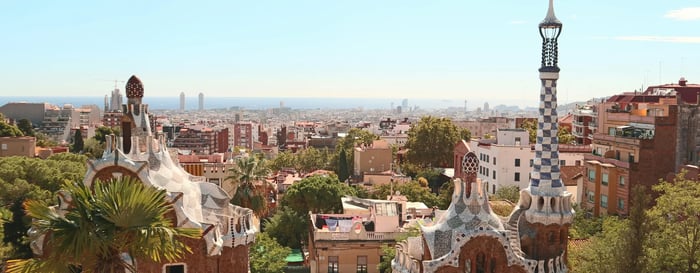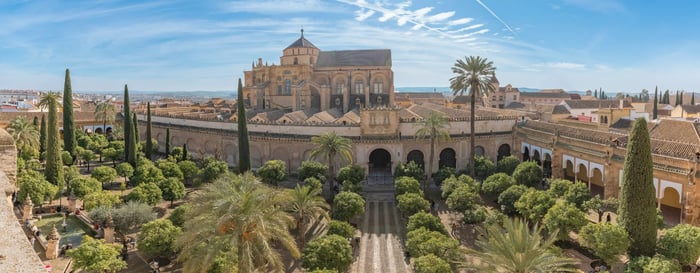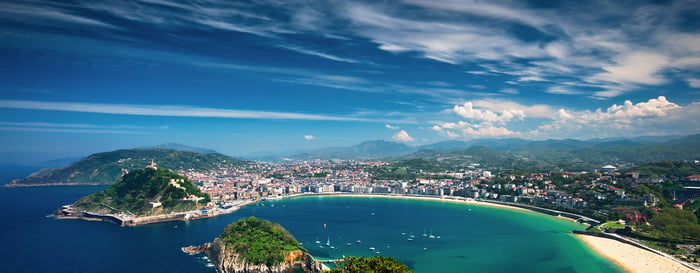I’ve always been fascinated by flamenco. Not the woman in scarlet with a rose between her lips – that cliché exists only in the tackiest of tourist shows – but the living art that stirs the blood and reaches deep into your soul. So when I found that I could visit three of Spain’s flamenco capitals in one trip, I immediately bought a train ticket to travel round the famed Flamenco Triangle (Huelva, Seville and Cordoba).
I started my journey in Huelva – home of the mournful cante jondo (deep song), lush green vegetation and extra virgin olive oil. Under a red-orange sun my guide, Francisco, took us past dusty hills punctuated with tiny whitewashed cottages and round-topped Eucalyptus. After visiting the Sierra de Aracena Nature Reserve and 10th-century hilltop mosque of Almonaster we drove to the Muelle de las Carabelas harbour where we could see huge replicas of Christopher Columbus’s boats in the dock. This may seem like a peculiar pit stop for a flamenco road trip, but it was from boats such as these that flamenco as we know it was born. For while Columbus and his fellow explorers brought back tales of new found lands, they also brought with them the music of new cultures. Traditional Spanish music began to absorb the musical influences of African slaves and Native Americans and the flamencos began to take on a more laid-back feel. The origins of these new flamencos were marked by their new name – ida y vuelta (round trip songs).

I received my first flamenco fix in Moguer where we thought it only right to mix some tunes with tapas. Peña del Cante Jondo is a flamenco club venue so steeped in flamenco history and memorabilia that despite my hunger, I struggled to focus on food. My salad of strawberries, peppers and exquisite local olive oil started to wilt, as I sat open mouthed while mini dramas unfolded around me. Mid-meal a seven-year-old girl left her mother’s knee to illustrate a move they were discussing and a teenager serenaded us with a Fandango de Rebolla so full of sweet sorrow that I temporarily forgot her tender age.
We then walked to one of the prettiest cities in the Sierra, Alajar. Francisco said, “this is heaven on earth’. I marvelled at a valley comprising more shades of green than I could possibly count, ancient twisted olive trees and a castle completing the scene and I couldn’t help but agree.
However, a little further down the road, in the town of El Cerro de Andévalo, I was about to come across another magical scene. As we walked towards the exquisitely tiled Chapel of the Holy Trinity, the sound of rhythmic clapping that filled the air, gave some clue to what we’d find behind the oak door.
As I entered the fresco-filled church turned arts centre I took one of the last spare seats within the nave.
A soulful song mixed with the musicians instantly hushed the audience and raised the hairs on the back of my neck. The series of verses produced by the semi-circle of flamencos (singers, guitarists, percussionists or dancers) was caressed by the acoustics made for this intimate ancient art form. More fandangos followed, which were songs of pride as well as loss. The whole experience was intoxicating.

Afterwards we returned to the hotel to party over great sherry, good beer and a selection of local delicacies including a thick chilled tomato soup known as salmorejo, and lamb decadently sautéd in the exquisite sherry Pedro Ximenes. I went to my room in the early hours of the morning, and fell asleep listening to the party downstairs.
The next morning, I managed to pack my suitcase and catch my first train from the Huelva’s heritage train station to the capital of Andalusia. The open squares with tinkling fountains, stunning architecture and hidden gardens are a few of the vivid impressions I would take from this picturesque city. There can be no better location for Don Giovanni, The Marriage of Figaro or The Barber of Seville. It’s the only place Don Quijote could have started his quest and that the tragedy of Carmen could easily unfold in the back streets or just around the corner.
Most good flamenco is close to my hotel in the Barrio Santa Cruz. Within this labyrinth of narrow streets, tribes of flamenco aficionados from all over the world come here to learn. We took a tour of the Museo de Flamenco, but after being spoilt with what we’d seen so far, I wanted to see the live version. Very late that evening my friend, Esther (a jazz flamenco singer and dancer) suggested a flamenco tablao. It was an intimate affair in a cramped café under an arch. Clever improvisations and subtleties of movement were greeted by shouts such as ‘esa’ (that’s it), ‘estas mujer’ (you’re [real] woman), and olé. This was how I wanted to see flamenco.
The early morning train trip from the slick Santa Justa Train Station in Seville to Córdoba was a blur and I was thankful that I could walk from the station to my hotel. For I needed to rush to Taller de Construcción de Guitarra Española where proprietor Manuel Reyes reeled off an impressive list of clients. He explained that the skills of construction are passed down from father to son; that flamenco guitars are different because they’re made of harder woods to be loud enough match the footwork and music, and for the tap plate that protects the guitar from golpe (rhythmic finger taps).

The friend of a local shop owner; a student of ancient Islamic writings at the city’s famous university, took me on a tour of the city and showed me the city’s Muslim legacy including the ancient souk located between the Mezquita and the 14th-century Almodóvar city gate originally known as Bab al-Chawz. We finished at the ornate Salón de Té de Salma, Casa Andalusí where I met other local academics eager to discuss the area’s cultural roots. They recommended the Córdoban Equestrian Centre where I saw Caballeros Reales, the Royal horse riders who antecedents went back to the reign of Abd al-Rahman (724-743) at the start of the Caliphate of Al-Andaluz. Seeing the horses’ enjoy performing made me wish I could have stayed to see more.
But I needed to rush to Cordoba Central Railway Station to catch a train once more to the city of Malaga. The darkening sky turned from luminous grey-blue to purple as I fell asleep. I missed the El Chorro gorge, the rows of man-high olive groves, and woke to see street lights fill the sky like golden globes.
My final stop was the Restaurant Vino Mio in Malaga where a dancer was spinning in her polka dot skirt on the dance floor. She invited some guests to leave their tapas behind and join her on the dance floor, but I decided to rest my heels and soak in the atmosphere. And with that it was time to complete my own round trip with a quiet flight home.
Explore Spain’s flamenco triangle – speak to our experts to start planning your tailormade Spain itinerary.
Amazing Barcelona & Magnificent Madrid
- Witness Gaudi’s incredible architecture at Barcelona’s Sagrada Familia
- Discover the surreal world of Salvador Dali in Figueres
- Glide over Montserrat Mountain in a hot air balloon
- Explore the sights, sounds and tastes of Madrid on a guided tour
- Wander the atmospheric streets of Toledo
Northern Spain Delights
Madrid Basque Country Barcelona Spain Europe
-
See famous artworks by Spain’s most celebrated artists
-
Enjoy a pintxos tour of San Sebastian with a local
-
Go wine tasting in La Rioja, Spain’s most renowned wine region
-
Discover the futuristic architecture of Bilbao
-
Explore Catalan Modernism with a tour of Gaudi’s most extravagant architecture








